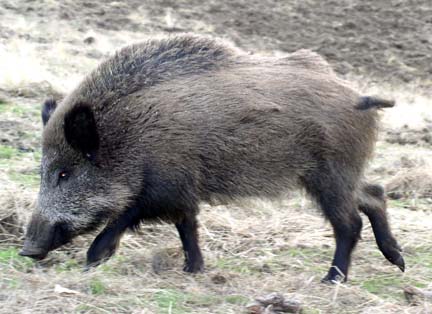European or Russian wild boar were introduced into the United States for hunting, so they are not native to North America. The original range of wild boar was Eurasia and North Africa. This range spanned from Ireland to Japan and southern Scandinavia to Egypt. Wild boar are actually the ancestors of the domestic pig and the two species can be successfully interbred. Russian wild boar are similiar to domestic wild hogs, but they differe physcially.
The terms standard and full-blood are applied to wild boar found in Canada. Standards have some domestic pig in their background, while fullbloods are considered to be pure wild boar. Crosses of the two produce hybrid animals. Fullbloods can be more aggresive than hybrids or standard wild boar, particularly if they are not raised in close contact with people. Physically, wild boar look very different from domestic pigs. Wild boar have smaller ears and much longer snouts than feral hogs. In addition, their tails are straight and tufted at the tip. Hair coloring is brown to black. Long bristles run from the head along the center line of the back and can be raised two to three inches from the body when wild boar are excited or agitated.

The hind legs of wild boar are shorter than their front legs, givng them an “uphill” appearance. Mature wild boar can measure up to 40 inches at the shoulder! To add to their tough appearanbce, males can weigh up to 450 pounds and females up to 350 pounds. Genetics and nutrition play a significant role in the ability of individual wild boar to reach a larger size.
Female (sow) wild boar can produce up to three litters per year under ideal conditions. However, two litters are are probably more normal. Gestation for wild boar is 114 days and litters average four to five young, although individual mature sows can produce as many as ten piglets. Like other wild animals, enviromental conditions strongly effect the productivity of femals. Under adverse environmental conditions, the number of piglets produced by a herd can average as few as one or two per sow. Young pigs are born with yellowish-brown coats and with distinct darkm horizontal stripes along the back. This coloration provides excellent camouflage for young wild boar.
One thought on “The Russian Wild Boar”